The following is a transcription of the Jubilee Souvenir
book published by the Desborough Industrial & Provident
Co-operative Society Ltd. Click on any image for a larger version
(in a second window), although the quality of the originals
and of the original printing means that it has not been possible
to make all the enlargements very clear.
CO-OPERATION IN DESBOROUGH
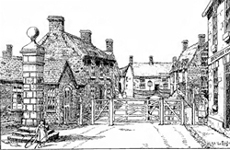
Adapted sketch of Toll-Bar
|
 |
Preface
In
the compilation of this brief History it has been our
endeavour to record events that have taken place
from time to time during the Society's inauguration
and progress to the present day. Our aim has been to
make it interesting to all: to the old, in the hope that
they will be filled with pride that their early efforts have
been so fruitfully crowned with success ; to the younger
generation, in the hope that they will be prompted to
study the principles and ideals of the movement; and
to the members generally, that they may more readily
realise their responsibilities, and give whole-hearted
support to their business establishments, and in other
ways obtain the best advantages from united action,
striving to educate and uplift the people to a more
equitable distribution of the nation's wealth. Very few
authentic records of the first twenty years of the Society's
existence being available, we have had to rely mainly
upon many of the older members for information.
R. M. Sanders.
Chris. Marlow.
Jesse Marlow.
Illustrations.
- Adapted Sketch of Toll-bar
- Copy of Old Map of Desborough Parish
- Map Showing in Black Area of Land belonging to Society
- Old Handloom Weaver
- Site of Old Pound and Lock-up
- Old Cross
- Desborough Church, from Rothwell Road
- High Street
- Old Tithe Barn
- Original Shop, 48, High Street
- The Original No. 1 Member (Edward Coe)
- Original Committee and First Storekeeper
- Past Treasurers of Society
- Henry Marlow, First Secretary, 1863
- William Allen, Past Secretary (until 1886)
- Premises after the Fire, 1891
- No. I Stores
- King Street Branch
- Drapery and Clothing Departments
- Butchery Department
- Coal Department
- Union Street Cottages
- Rushton Road Cottages
- A. J. Palmer, Cashier
- John N. Lester, Sole Agent for Sale of Ore
- General Committee
- Educational Committee
- Jubilee Festival Committee
- Women's Guild
- Federation Avenue Cottages
- Thorpe Underwood
- Heads of Departments
- Office Staff
- General Office
- Employees Distributive Departments
- Jesse Marlow, Present Secretary, 1886-1913
- William Kay, Public Auditor
- Chris. Marlow, Local Editor of Wheatsheaf
- George Marlow, Chairman, 1893-1913
- Farm and Estate Men
- View in Flaxland
- View in Rail's Field
- View, Manor Farm
- Sheep Shearing & Sheep Washing
- Poultry Feeding
- View on Farm
- Threshing on Farm
- Loatland Wood Farm
- Iron Ore Quarrymen
- Making Quarry Embankment
- Quarry Railway Cutting
/ Part of Iron Ore Quarry Works
- Locomotives, "Progress" and "Jubilee"
- General View of Clay Works and Entrance to Quarry
- Employees. Brick Works
- Excavating Clay / Pressing Bricks
- Engine House
- Dunkirk Avenue, Latest Estate Development
- Boot Society's Factory
- Interior of Boot Factory
- C.W.S. Corset Factory
- Employees C.W.S. Corset Factory
TO OUR MEMBERS
IN
presenting this History the Management Committee
desire to gratefully acknowledge their indebtedness to the compilers, to those
friends who have helped in any way, and to Mr. Howard Marlow, who favoured us
by preparing a special title and contents page, also sketch
of the Tithe Barn, &c.
For the Committee,
George Marlow, President
June 13th, 1913.
JUST south of the present town of Desborough,
on the north side of the valley of the Ise,
Celt, Saxon, and Roman relics from time to
time have been unearthed. It appears from
such evidence that both Saxons and Romans
settled here. The earliest written records,
however, are those relating to the Desborough Manor
at the time of the Conqueror's survey. They state that
Robert de Todeni, to whom Hugh was under-tenant,
held half a hide of the Crown, Ambrose held one hide and
one virgate of William Peverell, and Alan one virgate of
the Earl of Morton, the Earl of Morton being half-brother
to William the Conqueror. The whole of the lordship,
including a mill of the yearly rental of 2s., was valued
at 65s.
The next record states that in the reign of Edward
II., about 1315, the prior of the Hospital of St. John of
Jerusalem, . . . Burdon, Nicholas Latymer, and
John de Hotot were lords of Desborough. For many
generations the principal estates remained in the
possession of the Burdon and Latymer families, when
they passed through the Holt family to the family of
Pulton. About a century and a half ago the manor,
with the greater part of the lordship, was still held by the
Pulton family, who inherited their estate here for fourteen
successive descents. After the Pultons Mrs. Wyse came
into possession of the manor estate, and up to the
middle of last century enjoyed all the manorial privileges.
It then passed into the hands of the Clarke-Thornhill
family, who held it until 1898, when it came into the
market. The Co-operative Society purchased it for the
sum of £16,000. The ownership of this estate carried with
it the right of presenting the living of the parish church,
but the Society, having no desire to dictate to the churchmen
what sort of vicar they should have, relinquished
the right of presentation to the bishop of the diocese.
Local
The old town dates its origin from very ancient times,
and is situated on the main road from London and
Kettering to the north. Its main, or High Street, has a
very pleasant aspect, it being rich in quaint old inns
—
rambling structures that recall " the good old days " of
coaching times. This street in times past, near the
stone cross, was graced with an old toll-bar and wooden
stocks. And on the site of the Co-operative Society's
butchery premises stood the old " lock-up " and "pound."
With its many architectural features and grotesque gargoyles
there stands at the southern end of High Street
the beautiful parish church of St. Giles. Its splendid
symmetrical steeple can be seen for many miles around.
This church, which is said to have been built about 1250, is constructed of Weldon grey stone—a stone which
is a familiar feature in architectural work in this district.
Amongst other buildings that may be mentioned as being
worthy of note are the Baptist Church, Congregational
Church, Wesleyan Church, the Oddfellows' Hall, and
the beautiful suite of council schools erected for the town
by the old School Board.
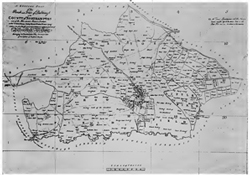
Old Map of Desborough Parish |
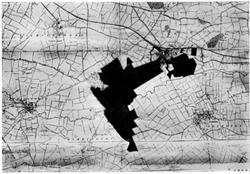
Map Showing in Black Area of Land belonging to Society |
Industrial History.
During all the changes and upheavals of the Middle
Ages Desborough made little or no industrial progress.
Generation after generation ploughed and sowed,
gathered in the harvest, and tended cattle. This
monotonous existence continued until the industrial
awakening of England at the beginning of the last century,
when Desborough became a centre for the silk plush
trade. Worsted waistcoat weaving was also carried on
at 53 to 57, High Street, these cottages being a factory at
that time. Then there was a considerable trade done
in gentlemen's waistcoat embroidery, followed by lace
embroidery for women. These industries, however,
gradually died out. Coloured plush waistcoats were very
fashionable at one time, but fashions change, and this did,
and 500 plush weavers are said to have been thrown out
of employment in Desborough. The ordinary handloom
weaving was effectually killed by the invention of the
power-loom. Manufacturers in the North of England, by
adopting the new methods of weaving, soon captured all
the trade from the handloom weavers in the villages.
William Burditt appears to have been the last weaver to
carry on his trade in Desborough. He worked his loom
in a now extinct house near 37, Gold Street.
When the weaving trade left Desborough industrial
conditions were very bad until the opening of the Midland Railway in the early sixties. Desborough then rose to
a new era of activity, the boot and shoe industry being
then established. And it is from this period that the town
has made such great progress.
Social and Industrial.
The town of Desborough has not come prominently
into notice in everyday affairs. Hidden away in the
north of Northamptonshire, it has done very little to make
itself nationally known. Yet, from both a business and
a social standpoint, the town is worthy of notice.
Desborough is governed by an urban council, the area
of whose administration comprises some 2,240 acres, with
a population of 4,300. The cost of administration is
comparatively small for a newly-developed district.
From a residential and social standpoint Desborough has
many advantages. The air is very bracing, and the
death-rate is low. The locality is considered a very
healthy one, and being situated between four hundred
and five hundred feet above the sea level, with the
country around hilly and well wooded, Desborough is
in the midst of some of the most delightful pastoral
scenery to be found. It possesses a very valuable water
supply, derived from the oolitic water-bearing strata
known as the Northamptonshire sand. The water is
drawn from large areas north and east of the town,
pumped into a reservoir, and supplied to the town by
gravitation.
The town as a manufacturing centre is well situated,
land being plentiful and cheap, and railway communication
with London and the North being both easy and quick.
Desborough is 81 miles from London and 20 miles from
Leicester, whilst Birmingham, Rugby, Nottingham, and
Northampton are all within easy distance.
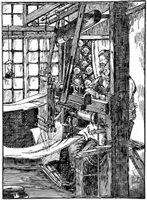
Old Handloom Weaver |
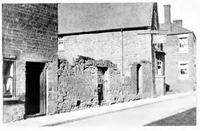
Site of old Pound and Lockup |
Amongst the commercial concerns flourishing here,
perhaps it will not be thought too presumptuous if first
mention is made of the Co-operative Society. So many
and varied are its agencies that we give a list of its
different departments:—Land and Houses, Savings Bank,
Grocery, Drapery, Clothing, Boots, Millinery, Hardware,
Furniture, Confectionery, Bakery, Butchery, Farming
and Grazing, Dairy, Brick and Tile Making, Iron-ore
Quarrying, and Coal Distributive Department. There is
also a Copartnership Boot Manufacturing Society known
as the "Crompton Boot Manufacturers Limited," and
the Co-operative Wholesale Society have their Corset
Factory established here. Private enterprise is represented
by the boot and shoe industry and iron-ore mining.
Perhaps the most apparent sign of the prosperity of this
town is the "well-to-do" appearance of the working-class
section of the population, and the considerable stake they
have in the district as landowners. Nearly every male
adult possesses an allotment or small holding, having
bought and paid for them through the Co-operative
Society's land purchase scheme, a scheme by means of
which the working men of Desborough have been able to
acquire a position the like of which few similar communities
have excelled. This Co-operative scheme has
covered other areas with houses to be let or sold on easy
terms to its members. And in addition to this the Society
builds houses according to the members' requirements;
thus a good house is obtainable at the lowest market
value.
Last, but not least, of this Society's enterprises was
the acquiring of the Manor Estate, Church Farm Estate,
Loatland Wood Estate, and the Thorpe Underwood
Estate, amounting in all to the total of 1,100 acres. A
small portion of the above is let to a local farmer, but all
the other is being developed in the interests of the Society. Farming operations, iron-ore quarrying, and brickmaking
are all being carried on ; whilst large portions are laid out
from time to time, as the demand arises, into building
lands with gardens.
District.
The district around Desborough is rich in historical
and antiquarian interest.
Desborough is near to the centre of Cromwell's
operations, and large bodies of Roundheads bivouacked
near here. It was from Market Harborough, five miles
distant, that Cromwell dated his letter to Lenthall, Speaker
of the House of Commons, with an account of the
engagement at Naseby. Naseby Plain is really a plateau
or table-land, from whence one obtains an extensive view
which comprises some forty churches, while the rivers
Avon, Welland, and Nen each have springs in the vicinity.
The village of Naseby occupies the highest ground in
Northamptonshire. The obelisk which stands on the
highest part of Naseby Plain bears one of those moralising
inscriptions which were so popular early in the last
century:—"A useful lesson to British Kings, never to
exceed the bounds of their just prerogative; and to
British subjects, never to swerve from the allegiance due
to the legitimate monarch." The area of Naseby Plain
is about 3,376 acres. Up to the year 1822 this was a bare
expanse of heath without tree or hedge, but since the Act
of Enclosure this sterile aspect has been considerably
mitigated, and the Plain is now a thriving agricultural
village, the greater part of which is owned by Lord
Annaly, who is also the fortunate possessor of the historic
Holmby House.

Old Cross |
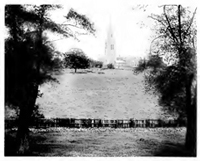
Desborough Church from Rothwell Road |
Previously to the battle Fairfax was encamped near
Borough Hill, while the King's headquarters were at
Market Harborough, and his rearguard at Naseby. In
a skirmish Ireton attacked Naseby and drove off the
Royalists. On the fatal morning of June 14th, 1645,
Fairfax advanced from Guilsborough and made his
rendezvous at Naseby by five in the morning. Soon
afterwards great bodies of the Royal Horse were seen on
the top of the hill towards Harborough. Fairfax drew
up his army in a fallow field on the north-west side of
Naseby field, flanked by a hedge. This movement of
retirement brought out the Royalists in battle array.
The numbers engaged on either side were about equal,
but Charles' army excelled vastly in seasoned officers.
After the battle the Royalists were pursued almost to
Leicester, and 5,000 of the retreating force were taken
prisoners. The unfortunate King escaped to Leicester,
thence across Charnwood Forest, the blue hills of which
form a delightful view to the north of the historic battlefield,
thence to Ashby-de-la-Zouch into Wales.
Among the objects of interest discernible from Naseby
field are the remains of the great mansion of Holdenby
or Holmby, erected by Sir Christopher Hatton, which
served first as a palace and, later, as a prison for Charles.
In the opposite direction are the Borough Hills, an
ancient British stronghold, called, by Tacitus Benvenna,
equivalent to Ben-Avon, or the head of Avon. More
northward at a like distance stands Lutterworth Church,
wherein is still preserved the pulpit whence Wycliffe
uttered his denunciations. West of this, but hardly
visible, is the High Cross, another obelisk with an
inscription concerning the intersection at this point of two
great Roman roads, and also one of Claudius,- who "had
a camp toward the street, and toward the fosse a tomb."
In the old days the advocates of the divine right of
kings ascribed the sterility of Naseby field to a curse
from heaven, on account of the share which the field
bore in the discomfiture of Charles ; the actual cause being doubtless the interment of the 6,000 slain men beneath
it. Naseby has a remote relation to Shakespeare, for the
Warwickshire Avon, which he knew so well, rises at the
Avon-well, opposite the Church. Some time back the
lord of the manor formed a handsome basin for the
spring, and over it placed a stone swan. Our Ise also
rises in Naseby parish.
Within two miles of Desborough is the pretty, little
town of Rothwell, which possesses a curious old market
house, built by Sir Thomas Tresham, who lived at
Rushton Hall, about three miles distant. The quaint
old structure was left unfinished, and remained so until
recently, when it was completed by the local Council.

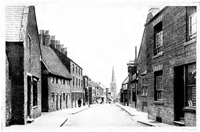
High Street |
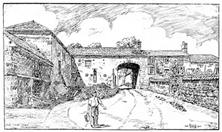
Old Tithe Barn |
It was during the latter part of the decade
commencing 1850 that Co-operation, in the
form of Distributive Societies, made rapid
headway in the Midlands. The artisans of
Desborough were weavers at this period. The message of Co-operation was brought to
them from Leicester and Market Harborough. A fervent
missionary named Mr. John Jarman also expounded its
principles in their midst. He came from the small village
of Clipstone, a remote village which has reared more than
one genius, notably the Jarman who worshipped at the
shrine of Orpheus. It was the day of the village choir,
a day associated in our minds with the names of Burditt,
Aprice, Foster, and Freer, as well as that of Jarman,
who became a composer of good repute.
The silk plush and velvet weavers at that time in
Desborough were a very clean, healthy, and intelligent
class of artisans. It was amongst these men that the
first seeds of collective effort were sown, and the sapling which was eventually to develop into such sturdy growth,
and bear such wonderful fruit, first took root.
At this time the industry of lace-making was introduced
through the agencies and representatives of
manufacturing firms from Leicester and Northampton.
These agents amassed fortunes by means of an unhealthy,
slavish system known as the truck system. The agents
took advantage of their positions as agents. They gave
out work to the weavers and lace-makers on the understanding
that the money thus earned should be spent at
their own particular shops, for the agent was usually a
small private trader, such as a grocer and general dealer.
This method led to serious abuses. The craftsman
became no longer a man of real liberty; his independent
purchasing power was lost, and he soon found himself
bound hand and foot in the fetters of debt and other
obligations to the wily parasite of a shopkeeper. For
his skilled work he received goods, not wages. When
the finished work was taken in, the "trucksters" paid
him with second-rate groceries ; he rarely received money
in payment.
But a few men were beginning to think. The work
of the Co-operative missionaries began to show some
result. Meetings were held at the Cross, and the ethics of
Co-operation pointed the way to a system free from the
thraldom of debt. Following out the fundamental idea
of Co-operation, a few of the thinking men soon perceived
that it would be greatly to their benefit to concentrate
their purchasing power and to take collective action for
the supply of the necessaries of life. The grocer
"truckster," of course, ridiculed the idea of starting a
Co-operative Society. His negative arguments fortunately
were of no avail. The small group of pioneers were in
earnest. One of our old members tells, with a merry
twinkle in his eye, of how he borrowed £1 from the neighbouring grocer to join in the "ridiculous" venture,
but not telling him for what purpose he desired such a
magnificent loan.
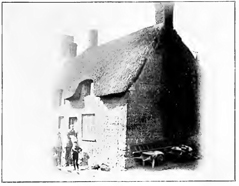
Original Shop, 48 High Street |
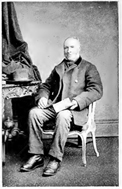
Original No.1 Member (Edward Coe) |
|
|
|
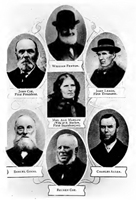
Original Committee and First Storekeeper
William Fenton,
John Coe, John Leago,
Mrs Ann Marlow (wife of Mr R Marlow, first Storekeeper),
Samuel Ginns, Charles Allen,
Reuben Coe |
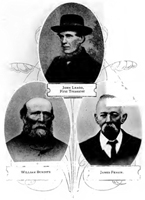
Past Treasurers of Society
John Leago (First Treasurer),
William Burditt, James Feakin
|
It was the custom amongst these weavers and the
agricultural labourers to procure goods from the grocer
and baker one week over another, paying for the previous
week's supply and taking the current week's goods on
"tick," being always a week behindhand, always in debt,
always fettered to the yoke so easily and craftily hung
about them by the wily traders, who at this early stage
posed as persons of "light and leading." However, these
"superiors" did not hesitate to corner goods, such as flour,
&c., when opportunity served.
One of our old members tells of how he was fettered
in this way by "strap; " how he longed to be free and
join the Store, but he could not, he having a wife and
eight children, and being in debt at the "white-haired,
beneficent grocer's." A farm labourer friend, however,
named John Ginns, who lived at Kilborn's Lodge, generously drew his accumulated
dividend out of the Society, and lent it to our friend to pay off scores and
become a free man, helping himself and helping others in the practical scheme of
trading as the Society had now set up.
1863.
So in the year 1863 meetings were held by the weavers
in Mr. Riley's room, and ultimately, at the final meeting
in the large room at the Talbot Hotel, 28 members were
enrolled, £28 capital subscribed, and a Committee formed.
Officers were appointed pro tem, as follows: John Coe, junr., Charles Allen, John Leago, Samuel Ginns, William
Fenton, Reuben Coe, and Robert Marlow, members of
first Committee. John Leago was first Treasurer;
Henry Marlow the first Secretary, and Robert Marlow was appointed the first Storekeeper. Goods were
purchased and sold in the little cottage now known as
No. 48, High Street.
The Society was launched at last, and the step then
taken has been amply justified. To these pioneers, who
banded together in such a brave and independent
manner, no small share of the success and prosperity
of the movement is due.
1865.
The Society was registered under the Industrial
and Provident Societies Act on September 4th, 1865.
Fortunately the writer was able to obtain sight of
some old written balance sheets, through the courtesy
of Mrs. William Allen. They show that in 1867 the
membership was 72, and the trade for the year amounted
to £1,208. Dividend was 1s. 8d. in the £, and the capital
was £134. In 1873 the membership increased to 91,
trade went up to £2,000, dividend was paid at the rate
of 1s. 2d. in the £, while the capital was £208, and the
reserve fund £12.
About this period the thoughts of Co-operators up
and down the country were devoted to amalgamation,
believing unity to be strength, with the result that the
Desborough Society early became affiliated with the
federation known as the Co-operative Wholesale Society.
This step has never been regretted.
1878.
Until the year 1878 the business of the Society had
been conducted first at the original shop, No. 48, High
Street, and then at a shop opposite the Talbot Inn, No.
75, High Street. From there a removal was made to
No. I, High Street, where an increasing business was
transacted. In 1878 a bold step was taken, the present High Street premises being purchased from Mr.
John Ginns, baker, and a commodious and convenient
extension was thrown out fronting the High Street. Here
a Grocery Department was conducted, and some years
later the furnishing shop and a house for the Storekeeper
were added.
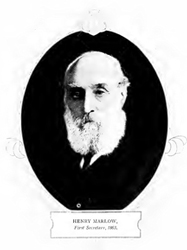
Henry Marlow
First Secretary, 1863 |
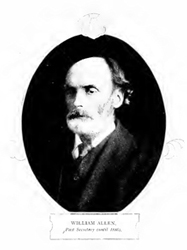
William Allen
Past Secretary (until 1866) |
At this period the Society could not boast of a Butchery
Department, but during part of the time meat was sold
by the Society through the agency of a Mr. Ross from
Leicester. He retailed the meat from his cart while on
the way to Kettering Market.
Mr. John Coe, who has already been mentioned,
bought the first two live pigs for the Society, and he
drove the pigs himself from Kettering Market. The pigs
were killed and dressed by Mr. Richard Coe, and retailed
to the members at the shop. No. 67, High Street.
1882.
In 1882 sufficient confidence was established to enable
the Society to commence the sale of meat on a proper
basis. The business was conducted at No. 109, High
Street. A butcher named- R. H. Ward was engaged to
carry out the required duties.
During the same year a site was purchased at the
corner of King Street and Rushton Road. On this site
No. 2 Store now stands. At this time the development
of the Society was rapid and continuous, and additions
and building accommodations were constantly carried out.
A glance at the following figures will amply demonstrate
this fact.
1883.
In this year the membership numbered 230, trade
amounted to £8,000, and dividend was 2s. 6d. in the £,
while capital stood at £1,706, and the reserve fund at £111. In the following year it was felt necessary that
the Society should supply coal. Arrangements were
accordingly made with the agents of private merchants,
and the members were able to supply themselves with coal.
In the same year the missionary spirit imbued the
Committee and the responsible officials with a desire for
representation at the Annual Congress. A delegate was
sent to the Congress at Derby in the person of Mr. William
Allen, and the local movement undoubtedly received a
stimulus from its first contact with the great national
movement.
1884.
The first District Conference was held at Desborough
in the year 1884.
1885.
Having found that the supplying of the necessities of
life could be carried out successfully, the members at this
time expressed a desire for the further development and
expansion of useful activities in other directions. In 1885
the No. I Allotment Estate was purchased, at £57. 10s.
per acre. This estate has been successfully developed as
an allotment and garden area. Every inch has been
bought and honourably paid for by the members. This
estate has now become very fruitful, besides being one of
the beauty spots of the neighbourhood. To a townsman's
eyes it is a real Garden of Eden.
During the same year the Penny Bank was started. This was founded to afford
suitable facilities for the convenience of small savings depositors. The sum of
£100 was deposited in the first year.
1886
The year 1886 was an anxious time with the members
of the now rapidly-growing Society. The No. 2 Store was built, and it was with no little amount of trepidation that
the Committee built a Store at the east end of the town.
They feared that the building of cottage property would
not keep pace with the requirements of such a commodious
Store. These fears proved to be unfounded,
and a successful Store has been run there ever since. At
this time No. 50, High Street was purchased in order to
accommodate the butchery trade, which was developing
rapidly, and a removal was made from No. 109. Here
Mr. Thomas Liner took charge.
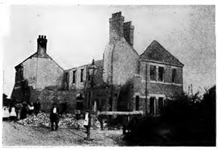
Premises after the fire, 1891 |
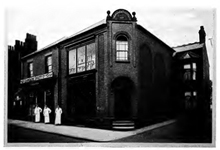
Number 1 Stores |
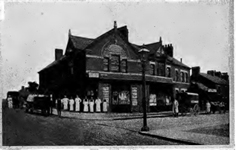
King Street Branch |
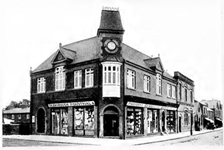
Drapery and Clothing Departments |
1888.
During this year the true spirit of Co-operation made
itself evident in the new attitude the members adopted
towards their coal trade. They considered the selling of
coal through private purchase to be anti-co-operative,
and decided to buy coal for the Society direct from the
colliery. This was a good step forward, and the sustained
success which has been evidenced by the Coal Department
has quite justified the action then taken.
1889.
In 1889 the Society arrived at its twenty-fifth
anniversary, and in looking back upon its humble
beginnings and, early struggles, everyone interested felt
that the Society had given a good reason for its existence
and had amply demonstrated its practical usefulness.
1890.
It had now been proved that the Society could act as
successful traders in food and other necessities of life,
and the experimental first land purchase had brought
increased prosperity. In 1890 it was deemed essential
that the Society should turn its attention to the housing of its members. Twenty cottages were accordingly
erected in Union Street, and have been sold to members
on the easy terms of 4s. 6d. per week. We believe that
the cottage owners who live there now thoroughly
appreciate the first attempt the Society made in building
comfortable cottages.
In this year the present educational fund was founded,
and £5 was apportioned from the profits to form the
nucleus of a fund for future propaganda work. How far
this has been usefully employed and effectively rendered
we leave it for our members to ponder over. A branch of
the Women's Co-operative Guild was started, and an
attempt was also made to form a Junior Guild. This
praiseworthy project died an early death, unfortunately.
It could not continue owing to lack of helpers. This is
very much to be deplored, as at present the social side of
our movement is somewhat neglected. If only the
young society could have lived, and if only we could have
continued our activities amongst the children right
onwards from its foundation, we should doubtless by
now have had amongst us many more sturdy and
vigorous enthusiasts for the cause of Co-operation as we
know it, actuated by keen loyalty to its principles of
justice and equity. At this time the Society sustained
a serious blow. The premises of No. 2 Stores were
practically all destroyed by fire.
1891.
In 1891 our second suite of offices were erected.
1893.
The membership reached 548 at the end of this year.
Trade amounted to £16,000; 2s. 6d. in the £ was paid
as a general dividend, 1s. 4d. in the £ for butchery, and
1s. in the £ for coal by the ton. Capital stood at £7,000. but the reserve fund stood at nil, owing to the loss
sustained by the afore-mentioned fire.
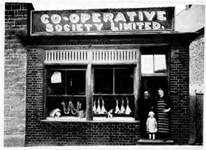
Butchery Department |
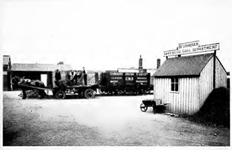
Coal Department |
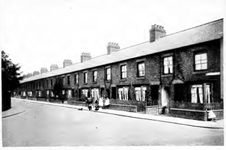
Union Street Cottages |
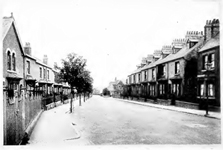
Rushton Road Cottages |
1894.
The No. 2 Estate was purchased during this year, £60
per acre being paid for the land. Fire loss amounting to
£400 was also cleared off this year, and the loyalty of
the members of the Society during this anxious period
cannot receive our too lavish praise and commendation.
1895.
In 1895 fourteen cottages were built in Queen Street.
At this time the decline of the Desborough Freehold Land
and Building Society provided the Co-operative Society
with a good opportunity for the purchase of properties in
Havelock Street, and various other pieces of land, from
the Land Society, and thus closed a very honourable
course of business by this Society.
1898.
In 1898 the erection of twelve cottages in Rushton
Road was commenced, and a tree-planting scheme was
discussed. Many curious objections were made against
the latter project for the beautifying of the highway.
Some of the more nervous stated that they dare not walk
abroad lest the trees should fall on them. Others were
fearful that their otherwise sound slumbers might be
ruthlessly disturbed by the noise of the wind playing
amongst the branches. The trees were planted, however.
At this time also the Manor Farm was purchased
from Mr. Bryan Clarke-Thornhill, as it was thought
essential that more land should be secured for the Society.
It does not seem so long ago since the old-time landlords
insisted upon their despotic rights, and were at liberty to plant barbarous man-traps about, hidden amongst the
undergrowth of their enclosed land.
BEWARE!
Man-Traps and Spring-Guns Set Here
was an announcement the writer well remembers seeing
on the walls of the Manor Hall yard. It was to serve
as a warning to trespassers and poachers and to those
who dare walk abroad carelessly over mother earth. It
served also to emphasise the jealously guarded and
savagely defended rights and privileges of the ruling class.
An illuminating contrast is afforded to-day in the fact
that our members may walk abroad on their own lands
free and unmolested. The spring-guns have gone, yet
we have lived long enough to realise that there are other
forms of traps for mankind. As Co-operators we have to
fight the ensnaring device of the lure for profit and the
cankerous growth of cruel, grasping greed.
At this time the office was removed from the rear of
No. I Store in High Street to 41, Station Road. The
Branch Butchery in King Street was also opened, and the
important responsibility of supplying pure milk to the
members was also undertaken by the Society.
Since this period the tendency to circumscribe the
liberty and ambition of our members as free handicraftsmen
has been very pronounced. He no longer enjoys
any control over his tools, materials, or time. His
pleasure in work and his joy of creation have been killed.
He is now merely an appendage to machinery driven by
a gas engine. We fear he has lost to a large extent his
security of tenure in his employment. He recognises, or
he must soon recognise, that he is but a wage slave to
the competitive system, as he is divorced very largely
from his skill as a maker of boots and shoes. The term
"bootmaker" now is a misnomer.
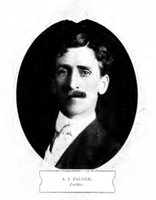
A. J. Palmer, Cashier
|
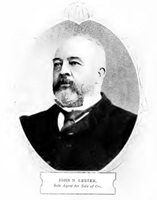
John N. Lester, sole agent for the sale of Ore
|
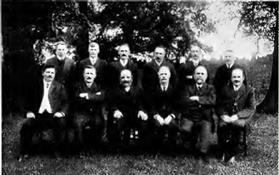
General Committee
Top: G. Plowright, A. Coe,
F. Cox, F. Coe,
G. Frost, J. Coe
Bottom: P. Thomas, R. M. Sanders, S. Panter, G. Marlow (President), J.
Marlow (Secretary and Manager), A. Panter |
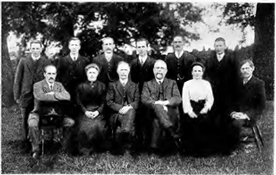
Educational Committee
Top: G. Plowright, S. B. Barnes,
G. Frost, C. Marlow,
F. Cox, H. Whymant.
Bottom: H. Crouch, Mrs. J. Coe, Jos. Marlow (Chairman), J. Marlow (Secretary),
Mrs. J. Marlow, H. Goodwin |
1900.
In 1900 it was felt necessary to build eleven more
cottages in Lower King Street. These are let at a rental
of 4s. 6d. per week.
1903.
A new drapery shop and assembly-room were built
in 1903. These premises are inferior to none in similar
towns to our own. The provision of a comfortable hall
allows facilities for the very useful propaganda and social
work of the Society. It is greatly to be deplored that our
members do not evince a greater desire to make more use
of it in this all-important direction.
1905.
This year was an anxious and pregnant year for the
Society. After many dubitations and hesitations, the iron
quarries were opened, and labour was employed directly
by the Society to work the pits. The greatest difficulty
appeared to be the placing of the stone on the market.
It was thought that the great capitalistic firms would
undoubtedly boycott us, as we were a Co-operative Society.
These fears were found to be groundless, and the halfhearted
ceased their questionings. We have constantly
placed goods on the market true to the nature and quality
required, and we are now recognised as reliable sellers
of good-quality iron ore. Our thanks are due to our
efficient representative, Mr. John N. Lester (of Wolverhampton),
and the practical oversight of Mr. John Clarke,
foreman of the works. Our output amounts to 2,000 tons
per week. We employ 120 workmen, and two locomotives
ply over two miles of railway. A sum of £7,000 is
paid away every year in wages. During this year also
the Society adopted the "Climax" check system. The
abolition of the old tin checks has been of great benefit to the Society, besides being much more hygienic from a
health standpoint, and more sound from a business point
of view.
1907.
In 1907 a new suite of Offices and a Boardroom were
erected, known as 41, Station Road, providing greater
facilities for routine work and for meetings of the Committee.
These buildings certainly do not disgrace the
Society.
1908.
It was recognised during this year that the Society
would soon be reaching the fiftieth year of its existence,
and the nucleus of a Jubilee Fund was formed.
A desire for the extension of farming operations was
also felt at this time, and Park Lane Farm, Braybrooke,
was leased for three years. At the end of that time the
lease was not renewed, as the farm was found to be very
unsatisfactory.
During this year a piece of land to the east of the
Bakery was bought, with a view to the extension of the
Bakery at some future date. The Society believes in the
policy of looking ahead, and not having to buy in an
emergency at greatly enhanced prices.
1909.
In 1909 the Clayworks were commenced. The new
Dairy accommodation was built, and machinery, engine,
and mill were put in at the Tithe Farm premises for the
preparation of fodder and the grinding of corn.
1910.
A series of rapid purchases of freehold land commenced
in 1910. A site on the north side of Harborough Road
was purchased. Part of this was to be developed as building sites, and part of it was to be used for coal
wharfage accommodation alongside the railway. This
was felt to be a very necessary development. Freedom
of action was now possible, and the necessity of paying
rents to monopolists abolished.
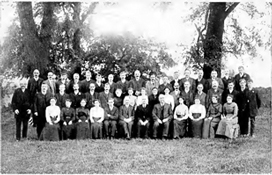
Jubilee Festival Committee
|
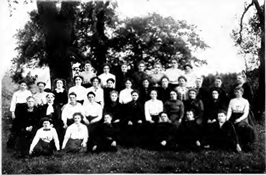
Women's Guild
|
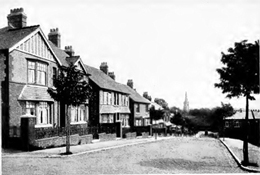
Federation Avenue Cottages |
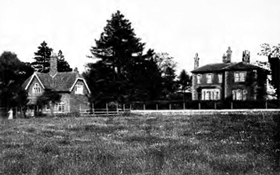
Thorpe Underwood |
In Harrington Road the New Close was also purchased,
and a large portion of the Church Farm and premises
also became the property of the Society. The Loatland
Wood Estate was bought during the same year, and in
1911 the Thorpe Underwood Estate was purchased. The
main purpose behind this transaction was a desire to
extend our mining operations, and to find employment
for our members, who, I think, appreciate the action of
the Committee on this point.
1912.
In 1912 the Urban Council opened up negotiations
with the Society as to the provision of new and more
extensive sewage farm accommodations, and also the
provision of a suitable recreation ground for the town.
The requirements were met in a satisfactory manner by
the Society, whose prompt and generous action has been
appreciated by all concerned.
The National Health Insurance Department was
opened during the year, and at the time of the coal strike
a relief fund was opened, as the quarrymen became great
sufferers owing to the dispute. Relief money was
advanced to them, and this has been most honourably
repaid by the men. By this action we trust that the
Society has made many more loyal adherents and faithful
friends.
The blight consequent on the coal strike had a serious
effect upon industry. It was not anticipated that
workers in other trades would have felt it so soon and for so long. It brought distress to our quarrymen. To those
men who could not be kept at work it meant, roughly,
a £1,000 loss in wages. The "rock-getters" could not be
retained all the time. The Committee did all they could
to provide employment wherever and whenever it was
possible, but scores of our fellows were compelled, by
forces over which they had no control, to seek odd jobs
about the town. Others were forced to receive assistance
in the form of loans, and others were aided by means of
organised charity. The Society came forward with a
gift of £21 in cash to the Relief Committee, and also gave
quantities of certain soups, &c., for the feeding of those
in need.
Some of the more fortunate had their share capital to
fall back upon. To-day, they must realise the advantage
of having the Co-operative Society at their backs to supply
sound goods at the cheapest rates, instead of at famine
prices, which latter are invariably charged when the
individualist-capitalist combine carries out its vaunted
dictum, "Buy in the cheapest market and sell in the
dearest," in the meantime formulating cunningly-devised
schemes to "rig the market," to oppose labour legislation,
and to restrict supplies before the trouble is over.
Before concluding this brief account it might not be
inopportune to refer to the educational activities of the
Society. In this direction the Society might do a far
greater work but for the lethargy of the majority of its
members. Lectures are arranged from time to time on
interesting or topical subjects. The lecturers engaged
are men of note and ability. A Library has been formed,
and the books are circulated from the Office. Some of
the finest modern works on social, political, economic,
and literary subjects are included in this Library. No
studious young fellow need be starved for want of
mental food and recreation. It is here, ready to hand. Conferences of the district are also held from time to
time, and the Wheatsheaf is published monthly. This is
a live little journal and deserves strong support in the
way of literary contributions.
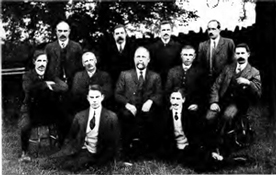
Heads of Departments
|
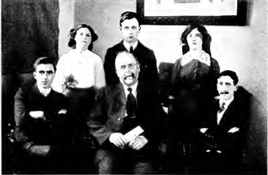
Office Staff
|
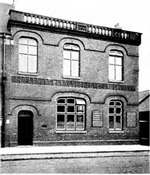
General Office |
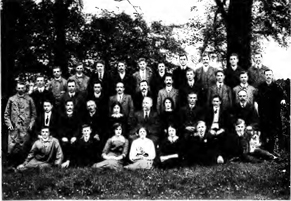
Employees Distributive Departments |
Even now the whole story of our Society has not
been fully told. As a Society we are local, yet, federated
with others, we are a part of the great national movement
as embodied in the Co-operative Wholesale Society, and
we are also associated with various Productive Societies.
Beyond that, the interests of International Co-operation
always take a prominent place, as we believe that these
international interests are united in the most vital manner
with the interests and prosperity of our movement at
home. Many of our old and respected leaders are passing
away. Let us, then, use every opportunity to spread
this great and peaceful gospel of home and world-wide
Co-operation. We are inspired by one faith and animated
by one cause, and that cause may be written as "The
good of all, the duty of each."
THE General Manager and Secretary of the Society
is a man who has won many triumphs. No martial
sounds have heralded his career. His life's work
is embedded in the Co-operative movement.
He attained his jubilee this year, he being about six
months old when the Society was formed. Born of poor
but honourable parents, he indeed is truly a man of "the
people," and he is never afraid of telling of his humble
parentage. His educational course was commenced at
a school kept by Dame Ruth Bamford, who was very
fond of making sugar candy, to the delight of little Jesse,
who often cast longing eyes for a sweet morsel. He
graduated at the Church Schools under the able teaching
of the late Rev. William Wilson and Miss Baggley, and
commenced work as a half-timer at the age of nine.
There was in those days little of the legal and social
solicitude which nowadays surrounds child life. In the
educated, smart business man of 1913 there is little
trace of the poor, ill-equipped lad who went into the
world with only his natural pugnacity and a stout heart
to overcome the obstacles which lay before him.
Throughout life he has been passionately devoted to
the people's cause, which he has championed in season
and out. Early in life he was taught the ethics of
Co-operation at home. He joined the Society in 1882,
and four years later was appointed to the responsible
position of Secretary. At this period the Society
numbered 316 members, with a share capital of £1,750,
loan £920, and 151 depositors in the Penny Bank. At the present time the number of members is 1,573, with a
share capital of £42,346; and loan, £7,721. The Small
Savings Bank depositors number 1,660, with a fund of
£4,504. The annual shop trade amounts to the magnificent
sum of £32,000, and the trade from productive
and other departments amounts to £22,299, making a
total of £54,299 per annum. The rapid and stupendous
progress made by the Society during the last decade is
in a large measure due to the untiring energy and zeal
of Mr. Jesse Marlow, who holds in his hands the strings
of a hundred and one different agencies connected with
the Society. Besides selling tea and sugar the Society
has launched its land purchasing schemes, its cottage
building schemes, schemes for productive development
and direct employment of labour, dairy farming, iron-ore
quarrying, &c. , and many other departments too numerous
to mention, all of which have been brought to a successful
issue. And through all the years, with their many new
departures, the Society has grown in usefulness and
stability and has ever retained the confidence of its
members. Happily the Manager and Society have nearly
always been blessed with progressive and enterprising
Committees, who have ever been imbued with the true
spirit of Co-operation. Besides his multitudinous duties
connected with the Society, which he always sets first,
he has found time to be for a dozen years an overseer of
the parish, and under the old system of assessment was
co-assessor of taxes. He is also a member of the County
Council. Some of his most valuable and most practical
work in recent years has been done for the County
Education, Smallholding, Agricultural Instruction,
Asylum, and the district Old-age Pensions Committees.
Technical education very naturally and deeply interests
him, and he has the distinction of being Chairman of the
local School Managers.
In 1906, owing to the recognised importance of the
Society's enterprise in land developments, he was honoured
by being called upon to give evidence before the Commission
appointed by the Board of Agriculture in an
inquiry upon the subject of smallholdings in Great
Britain.
It would be difficult in the compass of the space at
our disposal to refer to the many phases of Mr. Jesse
Marlow's character and work ; suffice it to say that he is
a keen observer with a reflective mind, unassuming in
manner, but possessing a dogged perseverance which has
helped him through many difficulties.
R. M. Sanders.

There was born 54 summers ago in the ancient
town of Rothwell "an atom" of humanity which
was destined to preside over the deliberations of
the most enterprising Co-operative Society in the Midlands.
Young George with his parents came to reside
at Desborough when he was eight years old. His course
of education being nearly complete, he soon began to
work for the "bread that perisheth." Truly his life was
like an obstacle race, full of barriers and difficulties, and
very early he learned that if you walk calmly up to the
obstacle and then try and clear it failure is the result.
It is the run, the momentum, that carries you over, and
this has been his practice through life, and it has helped
him through many difficulties. Very early in life he was
brought into touch with Co-operation in its primitive
moods. In his childhood days it was Co-operative
lullabys that wooed him to sleep, and as he grew up to
young manhood he was brought into constant touch
with the local Society. It is a significant fact that the
first £10 he ever saved in his life he loaned to the struggling
Society; this was several years before he became a
member. He joined the Society when he became of age,
the same year as he entered into matrimonial felicity. I
suppose at this particular time the Society would have
to "stump up" the £10 towards buying furniture, &c.
It is more than a generation ago since his official career
with the Society commenced, first as a member of the
Committee and for over twenty-two years its respected
President. During his term of office rapid strides have been made, and he tells a nice little story of sleepless
nights he had when the Society bought the Manor Estate
for the modest little sum of £16,000. For over twenty
years Mr. Marlow has served on the District Committee.
What Mr. Marlow has lacked in educational attainments
he has made up with force of character and honesty of
purpose. His character is portrayed in the maxim,
"Convince a man against his will, he holds the same
opinion still." When he once makes up his mind that a
certain course of action is right, woe betide the unfortunate
individual who impedes his course. The writer of this
article has had many "stacks up" with the President,
but they have never impaired our friendship. Mr. Marlow
is of a strictly religious turn of mind. For many years
he has been a member of the Wesleyan community, for
over twenty years a Sunday School teacher, and for some
years he was a church steward. The parish has also
claimed a part of his strenuous career. For a number
of years he was one of the overseers, and when the 1894
Local Government Act came into force he was elected
one of the first members. Mr. Marlow's earnest endeavour
is to so live and work that he will leave the world just a
wee bit better than he found it.
R. M. Sanders.
